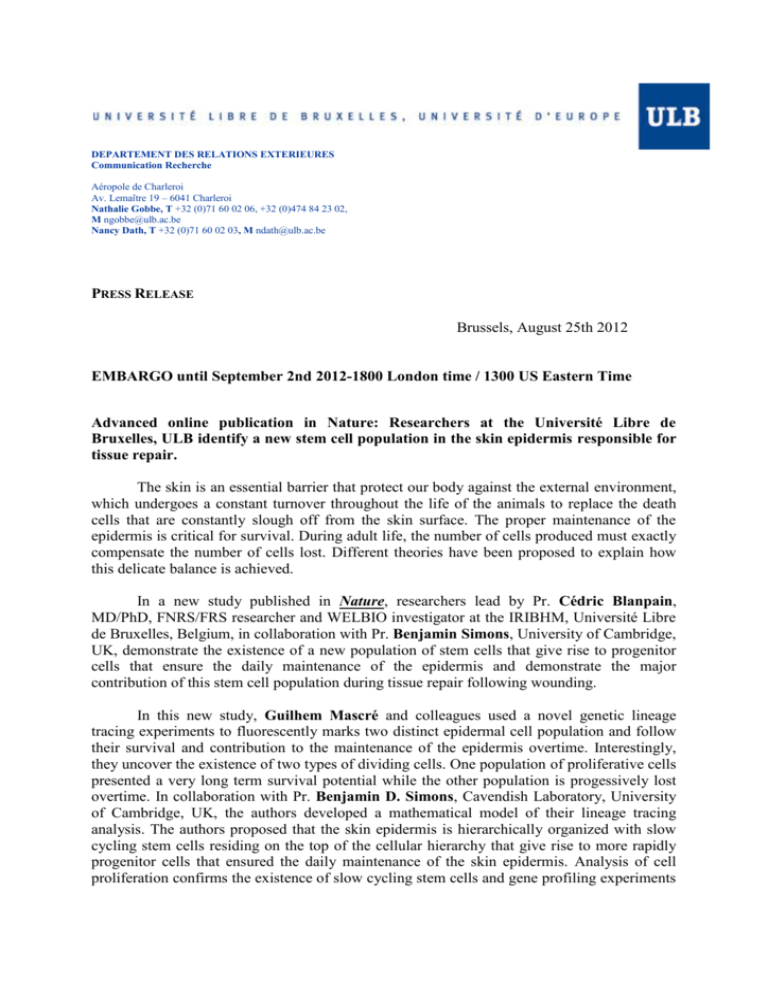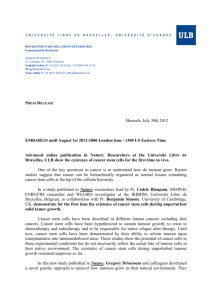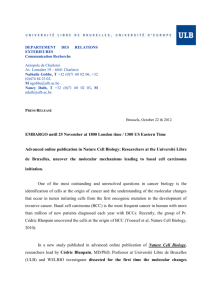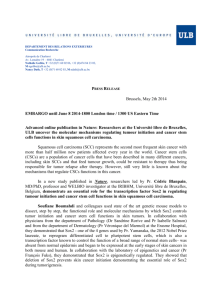DEPARTEMENT DES RELATIONS EXTERIEURES Communication
advertisement

DEPARTEMENT DES RELATIONS EXTERIEURES Communication Recherche Aéropole de Charleroi Av. Lemaître 19 – 6041 Charleroi Nathalie Gobbe, T +32 (0)71 60 02 06, +32 (0)474 84 23 02, M ngobbe@ulb.ac.be Nancy Dath, T +32 (0)71 60 02 03, M ndath@ulb.ac.be PRESS RELEASE Brussels, August 25th 2012 EMBARGO until September 2nd 2012-1800 London time / 1300 US Eastern Time Advanced online publication in Nature: Researchers at the Université Libre de Bruxelles, ULB identify a new stem cell population in the skin epidermis responsible for tissue repair. The skin is an essential barrier that protect our body against the external environment, which undergoes a constant turnover throughout the life of the animals to replace the death cells that are constantly slough off from the skin surface. The proper maintenance of the epidermis is critical for survival. During adult life, the number of cells produced must exactly compensate the number of cells lost. Different theories have been proposed to explain how this delicate balance is achieved. In a new study published in Nature, researchers lead by Pr. Cédric Blanpain, MD/PhD, FNRS/FRS researcher and WELBIO investigator at the IRIBHM, Université Libre de Bruxelles, Belgium, in collaboration with Pr. Benjamin Simons, University of Cambridge, UK, demonstrate the existence of a new population of stem cells that give rise to progenitor cells that ensure the daily maintenance of the epidermis and demonstrate the major contribution of this stem cell population during tissue repair following wounding. In this new study, Guilhem Mascré and colleagues used a novel genetic lineage tracing experiments to fluorescently marks two distinct epidermal cell population and follow their survival and contribution to the maintenance of the epidermis overtime. Interestingly, they uncover the existence of two types of dividing cells. One population of proliferative cells presented a very long term survival potential while the other population is progessively lost overtime. In collaboration with Pr. Benjamin D. Simons, Cavendish Laboratory, University of Cambridge, UK, the authors developed a mathematical model of their lineage tracing analysis. The authors proposed that the skin epidermis is hierarchically organized with slow cycling stem cells residing on the top of the cellular hierarchy that give rise to more rapidly progenitor cells that ensured the daily maintenance of the skin epidermis. Analysis of cell proliferation confirms the existence of slow cycling stem cells and gene profiling experiments demonstrates that the stem and the progenitors cells are characterized by distinct gene expression. Importantly, by assessing the contribution these two populations of cells during wound healing, they found that only stem cells are capable of extensive tissue regeneration and undergo major expansion during this repair process, while the progenitors did not expand significantly, and only provide a short-lived contribution to the wound healing response. This is the first demonstration of a critical role of epidermal SC during wound healing. “It was amazing to these long trails of cells coming from a single stem cell located at a very long distance from the wound to repair the epidermis” comments Cédric Blanpain, the senior author of this study. In conclusion, this work demonstrates the existence of slow-cycling stem cells that promote tissue repair and more rapidly cycling progenitors that ensure the daily maintenance of the epidermis. A similar population of slow cycling stem cells that can be rapidly mobilized in case of sudden need has been observed in other tissues, such as the blood, muscle and hair follicle, and the partition between rapidly progenitors and slow cycling stem cells could be relatively conserved across the different tissues. This study may have important implications in regenerative medicine in particular for skin repair in severely burnt patients or in chronic wounds. This work was supported by the FNRS, the « Brain back to Brussels » program from the Brussels Region, the program d’excellence CIBLES of the Wallonia Region, a research grant from the Fondation Contre le Cancer, the ULB foundation, the fond Gaston Ithier. Cédric Blanpain is an investigator of WELBIO and is supported by a starting grant of the European Research Council (ERC) and the EMBO Young Investigator Program Guilhem Mascré, Sophie Dekoninck, Benjamin Drogat, Khalil Kass Youssef, Sylvain Brohée, Panogiata A. Sotiropoulou, Benjamin D. Simons and Cédric Blanpain. Distinct contribution of Stem and progenitor cells to epidermal maintenance. Nature 2012, DOI: 10.1038/nature11393. Press Contacts: Cédric Blanpain, MD, PhD WELBIO, Interdisciplinary Research Institute (IRIBHM) Université Libre de Bruxelles (ULB) 808, route de Lennik, BatC, C6-130 1070 Bruxelles, Belgium Office: 32-2-555 4175 Lab: 32-2- 555 4190 FAX: 32-2 555 4655 Email: Cedric.Blanpain@ulb.ac.be Lab Website: http://blanpainlab.ulb.ac.be/index.htm Benjamin D Simons, PhD Herchel Smith Professor in Physics of Medicine, Cavendish Laboratory, JJ Thomson Ave, Cambridge CB3 0HE, UK Tel. +44(0)1223 337253/338738, Fax 337356, Admin. 337254 Email: bds10@cam.ac.uk







